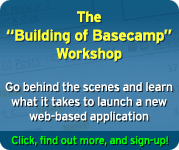Trimming Links
09 Jul 2004 by Matthew Linderman
Each e-mail we send to our Topica mailing list automatically includes a list of links at the end, like this:

I get why the “Update Your Profile,” “Unsubscribe,” and Topica links are there. But are the links to “Confirm Your Subscription” and “Forward to Friend” really necessary? If I get the e-mail and see the link, I’d say that’s a pretty decent confirmation of my subscription. And I doubt a ton of readers really need a web link in order to forward an e-mail to a friend. Sure, there’s always some reason to include “just one more link” but it’d be nice if Topica would just trim the fat.
7 comments so far (Post a Comment)
 09 Jul 2004 | Jake said...
09 Jul 2004 | Jake said...
If you built basecamp, surely you can create your own mailing list script :)
But yea, those are completely unnecessary!
 09 Jul 2004 | John Emerson said...
09 Jul 2004 | John Emerson said...
Dude, check out phpList.
It's a customizable, full-featured, Web-based mailing list manager that handles bounces just like Topica. And it's Free Software.
 09 Jul 2004 | Taylor Garries said...
09 Jul 2004 | Taylor Garries said...
I just installed PHPList. It could really use some 37Signals luuuvin', but all-in-all, works as exactly as advertised.
If you have a while to hack it together and get it to behave properly, I would highly reccomend it.
 10 Jul 2004 | Jes Sherborne said...
10 Jul 2004 | Jes Sherborne said...
Here are two possible justifications for a Forward to Friend link. Neither are particularly compelling, but both are at least plausible. It's at least as likely that nobody really thought it through at all, but I'll give them the benefit of the doubt.
1) A developer might think: "If the user forwards this email to a friend using the forward button in their email client, the forwarded email will have links to update the user's profile and unsubscribe. That's a terrible security hole. There's no way the user wants to let their friends unsubscribe them from the mailing list. Let's make a special link to forward this email so that we can resend it and strip all of these special links out of it."
This is a nice thought, but it won't work. Clicking a hyperlink, waiting for a web site, and interacting with its user interface are never going to be as easy as using the forward button on the user's email client. The developer's justification is too subtle for the user to perceive its value. Any user who understands the developer's security concern will just delete the hyperlinks before forwarding. Everyone else will just use the forward button anyway, because they can't see any reason not to.
2) The marketer thinks: "This is great. The user thinks this email is so interesting that he's forwarding it to one of his friends. There's a good chance that the friend will want to subscribe to the mailing list as well. If the user clicks our special magic Forward to Friend link, we get two things: first, we'll know the friend's email address, which we may be able to use for something. Second, we can add a new set of special links at the bottom of the email so that we can make it easier for the friend to subscribe."
Again, this reasoning fails because it doesn't add significant value for the user. Nonetheless, this kind of thinking is depressingly common (as I'm sure you've seen in your own consulting work).
The rationale for the Confirm Your Subscription link on an email to an already-confirmed subscriber is a mystery to me. Lazy programming?
 10 Jul 2004 | Chad Brandt said...
10 Jul 2004 | Chad Brandt said...
A client commented about this Topica feature recently. They wanted to remove everything but the "Unsubscribe". Unfortunately, Topica only allows the removal of the "Forward to Friend" link. Everything else is non-negotiable.
The links do look better in HTML, but continue to confuse users. In HTML format "Confirm Your Subscription" becomes "Confirm" and "Forward to Friend" becomes "Forward". Not very helpful.
 10 Jul 2004 | Will Pate said...
10 Jul 2004 | Will Pate said...
A better sig, which assumes you start running your own mailing list:
============================================
Profile:
http://mailinglist.37signals.com/profile/
Update your profile, confirm subscription and unsubscribe.
 12 Jul 2004 | Scott Dye said...
12 Jul 2004 | Scott Dye said...
I have noticed that with HTML emails, the html sometimes breaks when you forward it, which means my friend would get a jumbled mess. This seems to be especially true of Entourage on the mac. So an actual link in the email is the only way I can reliably send an HTML email to a friend (not that I really ever bother my frineds in this way).
It's also a matter of a "call to action" suggestion, just like putting "buy now" on an "add to cart" button. Both work, but one is more suggestive.
Not to beat a dead horse, but I can't even remember the people over the years who had no idea you even "could" forward an email until i showed them how. Every day I become reminded more and more that the "average" user knows next to nothing about how the internet really works.

